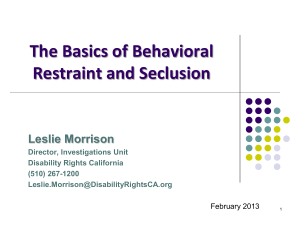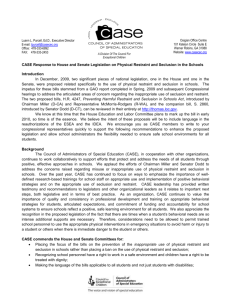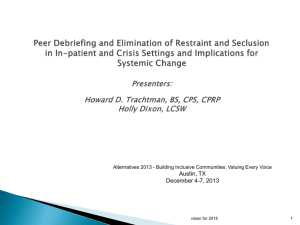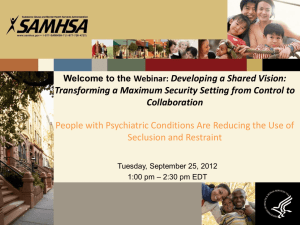Reducing Behavioral Restraint & Seclusion & SB 130
advertisement
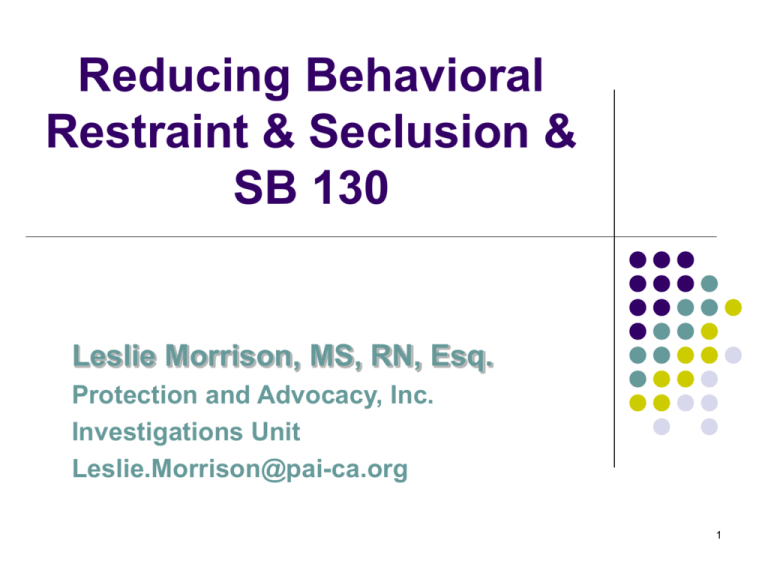
Reducing Behavioral Restraint & Seclusion & SB 130 Leslie Morrison, MS, RN, Esq. Protection and Advocacy, Inc. Investigations Unit Leslie.Morrison@pai-ca.org 1 Six Core Strategies Culture Change 1. Leadership toward Organizational Change Articulating [& living by] a mission & philosophy of reduction & elimination Management oversight of every S/R event (“witnessing”) Holding people accountable l l l Reduction action plan Performance improvement team 2. Use of Data to Inform Practice: publicly available l l l # of incidents, duration, injuries, [stat involuntary med use] By unit, shift, day, staff member Set improvement goals from baseline 2 National Technical Assistance Center & National Association of State Mental Health Program Directors DMH RESTRAINT STATISTICS Frequency and Duration per 1000 Hospital Hours 2005 1st Quarter 2005 Facility ASH MSH NSH PSH Total # of Episodes Duration per 1000 Hosp Hrs Seclusion 22 0.13 Restraint 253 Walking 2nd Quarter 2005 Mean Duration in Hours Total # of Episodes Duration per 1000 Hosp Hrs Mean Duration in Hours 16.5 56 0.41 20.20 3.02 32.55 283 2.38 23.52 75 0.22 8.0 83 0.20 6.90 Seclusion 46 0.04 1.2 4 0 1.30 Restraint 830 2.40 4.3 694 2.13 4.44 Walking 90 0.60 9.9 26 0.08 4.60 Seclusion 279 1.45 12.4 209 0.95 11.10 Restraint 444 4.49 24.2 562 6.05 26.23 Walking 185 0.83 10.7 214 0.92 10.50 Seclusion 341 1.11 9.4 311 0.93 9.20 Restraint 821 4.26 15.0 612 2.57 12.90 Walking 793 1.82 6.6 554 1.12 6.20 3 Napa State Hospital Total Restraint or Seclusion Hours 30000 Total S/R Hours 25000 24442.7 19294.3 Restraint 20000 17430.2 16183.6 15000 14740 Walking 10732.2 10000 9360.2 6443.2 3471.3 Seclusion 4898.5 3484.1 2241.6 1980.1 2312.7 5000 3729.7 3528.4 1485.6 1431.4 Jan-March April-June July-Sept. 2004 2004 2004 Oct-Dec. 2004 866.4 302.4 Jan-March 2005 0 4 3. Workforce Development “Culture Change” “Trauma Informed Care” “Recovery” l Training l Job Description l Performance Evaluation l Involvement of/equal partnership w/consumers, family members, advocates 4. Use S/R Reduction Tools l l Risk Assessment: trauma history, risk for violence, medical risks De-escalation plans: identifying emotional triggers; developing awareness of interpersonal & environmental stressors l l Comfort Rooms Daily Meaningful Activities National Technical Assistance Center & National Association of State Mental Health Program Directors 5 5. Consumer/Family/Advocate Roles in Inpatient Settings l Full & formal inclusion in S/R reduction roles: Director of Advocacy Svc, Peer Specialist, Consumer Advocate 6. Debriefing Techniques l Immediate post-event debriefing: assure safety, interview all involved, return to ‘pre-crisis’ milieu l Treatment team review: root cause analysis National Technical Assistance Center & National Association of State Mental Health Program Directors 6 Center for Medicaid & Medicare Services Webcast “Reducing the Use of Seclusion & Restraint in Psychiatric Facilities” [aired Sept. 23rd but available for viewing] “This broadcast was designed to provide a brief overview of the history of this initiative, emerging findings on effectiveness, a review of the core theories and literature that added support to the development of the 6 core strategies and recommendations for administrative and practice change.” http://cms.internetstreaming.com 7 SB 130 / Health & Safety Code § 1180 “The use of seclusion and behavioral restraints is not treatment, and their use does not alleviate human suffering or positively change behavior.” Treatment failure “The commitment of managers and staff is essential to changing the culture of those facilities and reducing he use of seclusion and behavioral restraints.” Involving clients Good milieu programs & attention to person’s needs 8 Components 1. 2. 3. 4. Alternatives l Technical assistance & training programs with consumer involvement l Intake assessment l Proactive interventions Safeguards Data l Mandatory, consistent, timely, publicly accessible Debriefing 9 Oversight Structure ultimately falls to HHS HHS DMH DDS DHS DSS State Hospitals Developmental Centers Hospitals Acute Psychiatric Hospitals Community Care Facilities PHF Community Treatment Facilities Chemical Dependence Recovery Hosp. Adult Residential Facilities Special Treatment Program at IMD Regional Centers Skilled Nursing Facilities, including IMDs Group Homes Intermediate Care Facilities (ICF) Residential Treatment Facilities Mental Health Rehad. Ctrs Certify Social Rehab. Program at RTFs & CTFs Community Service Vendors Standards for some ICFs 10 1. l Alternatives Intake assessment with consumer input Advanced directives to de-escalate, early warning signs/triggers, techniques that help person maintain/regain control, preexisting medical conditions, trauma history, l Proactive interventions Avoidance, crisis management, responding to reasons underlying behavior, conflict resolution, effective communication, positive early intervention l Technical assistance & training programs with consumer involvement Alternatives (above); trauma mitigation, minimizing duration, & ensuring safety when R/S H&S § § 1180.3(b)(2) & 1180.4(a) 11 2. Safeguards Prohibited: l l l l l Restraint that obstructs airway or impairs breathing Physical/manual restraint of person w/known medical/physical risks Prone with hands restrained behind back Containment as extended procedure Prone mechanical restraint with those at risk for positional asphyxiation, unless written authorization by MD Avoid prone containment l 1 staff to observe for physical distress Constant face-to-face observation when in seclusion AND restraint unless facility currently okay to use video Right to be free from use of a drug to control behavior or restrict freedom of movement & not standard treatment for condition H&S § 1180.4 12 3. Data A mandatory, consistent, timely, publicly accessible l l l l l l Number of incidents Duration of incident Deaths of patients occurring while or proximately related to S/R Serious injuries to patient and staff Number of involuntary emergency medications Available on internet Currently only state facilities reporting H&S §1180.3(c) 13 Physical, Non-ambulatory Restraint per 1000 hospital hours by State Hospital 8 NSH 7 6.89 6 6.05 PSH 5 4.49 4.26 System 4 3.67 3.72 3.33 2.57 3.02 MSH 3.77 2.57 2.38 2.4 2.27 2.21 3 2.58 2.29 2.13 2.77 2.25 1.61 1.47 1.11 2 1 0.63 ASH 0 Jan-March 2004 April-June 2004 July-Sept. 2004 Oct.-Dec. 2004 JanuaryMarch 2005 14 4. Debriefing ASAP [within 24 hours] with resident, involved staff & supervisor Purpose: How to avoid a similar incident in future? l Assist resident l Assist staff l l Identify precipitant Suggest safe, constructive methods for responding Understand precipitants Develop alternative to help resident Revise treatment interventions to address root cause Assess if S/R was necessary & done consistent with training & policies 15 H&S §1180.5 What’s Happened Since SB 130? l l Use, injuries & deaths reportedly & seemingly decreasing State facilities publishing some data l l l All other facilities – no data published l l HHS promises to move forward with mandated reporting from all facilities No technical assistance or training programs l l Improvements recommended Trending over time? Comparing with other facilities? State facilities revised training but w/out consumer involvement Continued problems with culture change 16 Definitions l Behavioral Restraint – restraint used as an intervention when a person presents an immediate danger to self or to others: l l l l mechanical – using a mechanical device, material or equipment attached/adjacent to person’s body that restricts freedom of movement physical – use of a manual hold to restrict freedom of movement of or normal access to all/part of persons’ body and is used as a behavioral restraint excludes medical, postural, devices to prevent injury or improve mobility Containment – brief physical restraint to effectively gain quick control of person who is aggressive or agitated or who is a danger to self or others 17 l Facilities l General Acute Care Hospitals l l l l l l l l l l l l Not ERs yet Acute Psychiatric Hospitals Psychiatric Health Facilities (PHFs) Crisis Stabilization Units (23 hour) Community Treatment Facilities Group Homes Skilled Nursing Facilities Intermediate Care Facilities Community Care Facilities Mental Health Rehabilitation Centers State Facilities Seclusion – involuntary confinement of a person alone in a room or an area from which the person is physically prevented from leaving; Excludes timeout Serious Injury – any significant impairment of the physical condition as determined by medical personnel, includes burns, lacerations, bone fractures, substantial hematoma, or injuries to 18 internal organs


